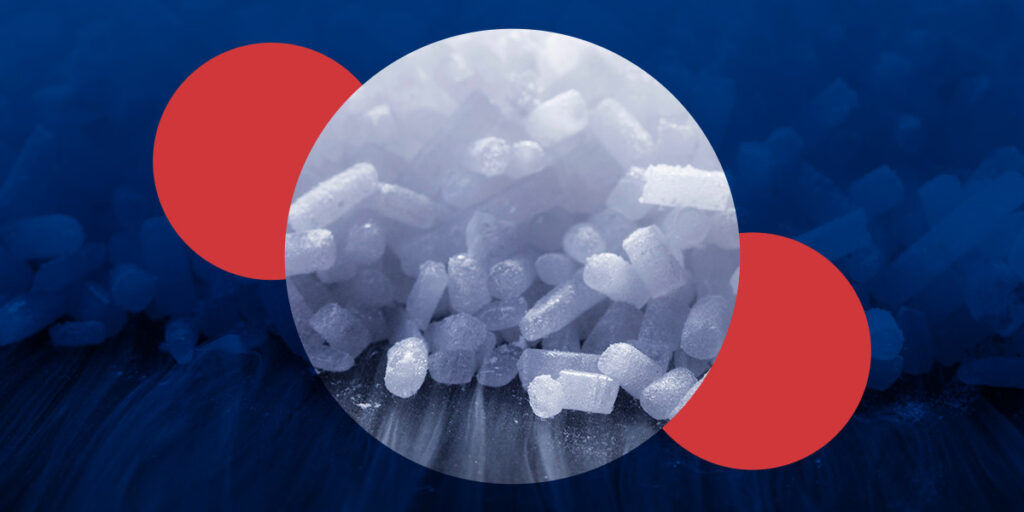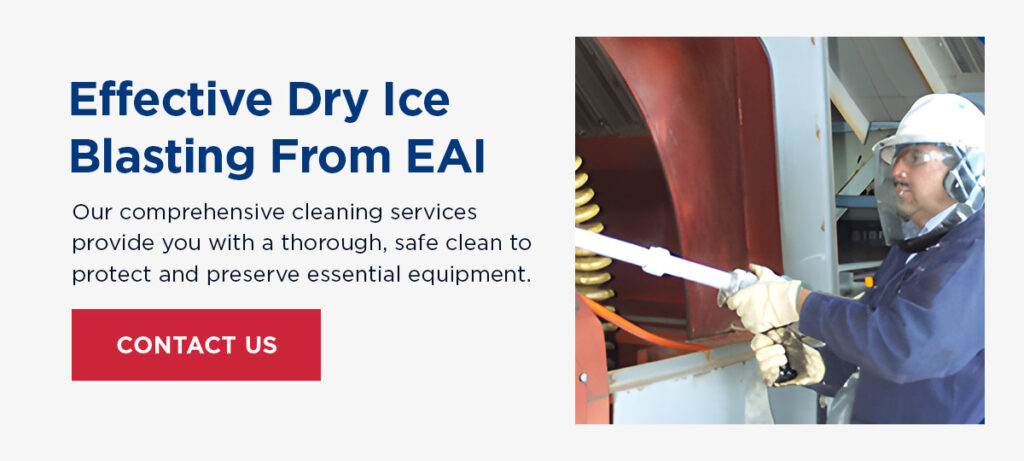What Is Dry Ice Blasting?
By Jessie West | May 15 2024

Industrial processes depend on specialized equipment to keep everything running smoothly and safely. Maintenance is a critical part of keeping this equipment at its best, and cleaning is an important step in removing buildup and protecting your equipment from wear. However, industrial equipment is often unusually shaped or delicate, making cleaning challenging. Dry ice blasting is an effective, nonabrasive cleaning technique that helps you protect your equipment while maintaining it effectively.
How Does Dry Ice Blasting Work?
Dry ice blasting is an innovative cleaning method that uses dry ice pellets to clean materials without abrasion. With this technique, a pressurized air stream blasts dry ice pellets at the work surface at high speeds. When the pellets hit the target area, they immediately go from a solid to a gas in a process called sublimation, lifting contamination away to clean without leaving residue.
Dry ice blasting effectively removes grime, dirt, debris, grease and contaminants from surfaces without harsh chemicals or abrasives, making it ideal for sensitive equipment and big cleaning jobs.
Industrial Applications of Dry Ice Blasting
Dry ice blasting is a highly versatile cleaning method that serves operations in many major industries. You might see dry ice blasting used in applications like:
- Power: Dry ice blasting is also a great choice for cleaning boilers, turbines, heat exchangers and generators in power generation facilities.
- Automotive: The automotive industry uses dry ice blasting to clean paint booths, engine parts, assembly line equipment and molds.
- Manufacturing: Dry ice blasting effectively removes contaminants from conveyors, machinery and production equipment.
- Electronics: The electronics industry involves many delicate components that need careful, abrasive-free cleaning, including circuit boards and assembly equipment.
- Food processing: Since dry ice blasting effectively removes contaminants without leaving residue, it’s a popular choice for cleaning ovens, packaging machinery, food processing equipment and conveyor belts.
Environmental Benefits of Dry Ice Blasting
Dry ice blasting is a highly sustainable process that still offers an effective clean. Where traditional cleaning methods often involve chemical waste, excessive water use and harsh abrasives, using dry ice results in virtually zero harmful byproducts. Take a look at the environmental impact of dry ice blasting:
- Eco-friendly CO2 blasting: Dry ice blasting uses reclaimed CO2, an eco-friendly alternative to harsh solvents and chemicals. Reclaimed CO2 is a byproduct of industrial processes — using it for cleaning purposes helps reduce environmental waste and supports sustainable cleaning solutions.
- Minimized pollutants: When dry ice pellets contact a work surface, they simply revert to their gaseous state, lifting away contaminants and leaving nothing behind.
- Reduced water usage: While traditional cleaning methods rely on lots of water, dry ice blasting uses none. You’ll help reduce water waste by eliminating this requirement from the cleaning process.
- Nonabrasive cleaning: Dry ice blasting is surprisingly gentle. The pellets effectively remove contaminants from your sensitive equipment via sublimation without causing scratching or wear. Keeping equipment in good condition with regular cleaning extends its service life, providing another environmental — and monetary — benefit.
Advantages of Dry Ice Blasting
Using a dry ice cleaner allows you to clean sensitive equipment with minimal waste. Investing in this process is a cost-effective decision that will help you keep your operation running smoothly and efficiently. While traditional cleaning methods can get the job done as well, you’ll save time and protect your valuable equipment with dry ice blasting.
Many operations prefer dry ice blasting for their cleaning needs because it is:
- Versatile: Dry ice blasting serves numerous industries. This gentle, effective process works equally well for automotive, restoration, manufacturing and food processing equipment.
- Environmentally friendly: As mentioned above, dry ice blasting is an eco-friendly cleaning solution. You get to reduce water use and waste without compromising effectiveness.
- Safe: Dry ice blasting doesn’t produce harmful fumes or residues like other cleaning methods, making the work environment safer for employees.
- Nonabrasive: This process is extremely gentle on your surfaces, removing contaminants without removing structural material from the target area.
- Clean process: Since dry ice blasting doesn’t require water, its cleanup requirements are minimal. With less cleanup work, you’ll minimize downtime and improve your productivity.
Dry Ice Blasting vs. Shock Wave Technology
Dry ice blasting delivers a quality clean with less risk of equipment damage and less waste than other cleaning methods. One of the technique’s chief competitors, known as shock wave or pressure wave cleaning technology, uses controlled shock waves to blast debris from inside tubes or off of coils. Both of these methods work to remove waste products from equipment sustainably and without the use of abrasives, leading many facility managers to compare the two for their cleaning requirements.
The following are a few of the key considerations you’ll want to keep in mind when choosing between dry ice blasting and shock wave technology for your facility:
- Environmental impact: Since dry ice blasting uses CO2 pellets for cleaning, it requires no solvents or harmful chemicals. Dry ice made on-site gives you a sustainable cleaning solution with no residue. Pressure wave cleaning also produces minimal waste since it uses pressure to blast off debris.
- Cleaning effectiveness: Dry ice blasting is highly effective at removing surface buildup and contamination, and it does so without leaving other substances behind because the pellets turn to gas on impact. With the energy and thermal shock of the pellets, you get a complete clean that leaves no damage and no residue. Meanwhile, shock wave technology penetrates deep into debris, but the pressure wave can leave some buildup behind if it can’t readily impact every surface. It’s therefore less effective for units like boilers with tightly packed coils and unusual configurations.
- Safety: Shock wave technology comes with shorter cleaning cycles and no need for scaffolding, which can make it a fast, cost-effective solution. However, using combustible materials and detonating cord curtains poses a safety risk. Meanwhile, dry ice blasting offers safer cleaning without concussion or requiring extensive safety precautions.
- Surface damage: Dry ice blasting is nonabrasive and can clean sensitive materials without issue. While shock waves also remove debris without needing abrasives, they may damage delicate components because they use force to penetrate buildup. Depending on the design of the parts being cleaned, pressure wave technology may not reach all surfaces as effectively as dry ice sublimation.
Today’s facility managers have multiple options for cleaning their equipment. If you’re not sure which is right for your operation, talk to a professional about the benefits of dry ice blasting compared to other methods to help you decide.
Effective Dry Ice Blasting From EAI
Environmental Alternatives, Inc. (EAI) offers expert dry ice blasting services to help you keep your industrial equipment clean. Our comprehensive cleaning services provide you with a thorough, safe clean to protect and preserve essential equipment. Our team will come to you and set up our dry ice production and blasting equipment on-site to keep downtime to a minimum.
Contact us online today to learn more about how we can help you!




